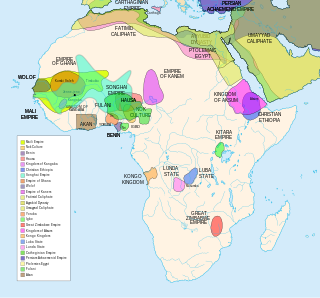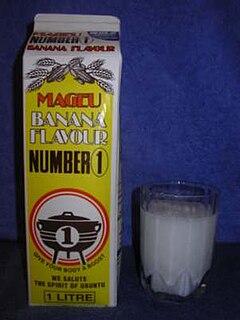Related Research Articles

Boers are the descendants of the Dutch-speaking Free Burghers of the eastern Cape frontier in Southern Africa during the 17th, 18th, and 19th centuries. From 1652 to 1795, the Dutch East India Company controlled this area, but the United Kingdom incorporated it into the British Empire in 1806. The name of the group is derived from "boer," which means "farmer" in Dutch and Afrikaans.

The history of Africa begins with the emergence of hominids, archaic humans and - around 300–250,000 years ago—anatomically modern humans, in East Africa, and continues unbroken into the present as a patchwork of diverse and politically developing nation states. The earliest known recorded history arose in Ancient Egypt, and later in Nubia, the Sahel, the Maghreb and the Horn of Africa.

The first modern humans are believed to have inhabited South Africa more than 100,000 years ago. South Africa's prehistory has been divided into two phases based on broad patterns of technology namely the Stone Age and Iron Age. After the discovery of hominins at Taung and australopithecine fossils in limestone caves at Sterkfontein, Swartkrans, and Kromdraai these areas were collectively designated a World Heritage site. The first nations of South Africa are collectively referred to as the Khoisan, the Khoi Khoi and the San separately. These groups were displaced or sometimes absorbed by migrating Africans (Bantus) during the Bantu expansion from Western and Central Africa. While some maintained separateness, others were grouped into a category known as Coloureds, a multiracial ethnic group which includes people with shared ancestry from two or more of these groups: Khoisan, Bantu, English, Afrikaners, Austronesians, East Asians and South Asians. European exploration of the African coast began in the 13th century when Portugal committed itself to discover an alternative route to the silk road that would lead to China. In the 14th and 15th century, Portuguese explorers traveled down the west African Coast, detailing and mapping the coastline and in 1488 they rounded the Cape of Good Hope. The Dutch East India Company established a trading post in Cape Town under the command of Jan van Riebeeck in 1652, European workers who settled at the Cape became known as the Free Burghers and gradually established farms in the Dutch Cape Colony.
The written history of the Cape Colony in what is now South Africa began when Portuguese navigator Bartolomeu Dias became the first modern European to round the Cape of Good Hope in 1488. In 1497, Vasco da Gama sailed along the whole coast of South Africa on his way to India, landed at St Helena Bay for 8 days, and made a detailed description of the area. The Portuguese, attracted by the riches of Asia, made no permanent settlement at the Cape Colony. However, the Dutch East India Company (VOC) settled the area as a location where vessels could restock water and provisions.

Khoisan, or Khoe-Sān, according to the contemporary Khoekhoegowab orthography, is a catch-all term for those indigenous peoples of Southern Africa who do not speak one of the Bantu languages, combining the Khoekhoen and the Sān or Sākhoen.

The history of the Cape Colony from 1806 to 1870 spans the period of the history of the Cape Colony during the Cape Frontier Wars, which lasted from 1779 to 1879. The wars were fought between the European colonists and the native Xhosa who, defending their land, fought against European rule.

Khoekhoen are the traditionally nomadic pastoralist indigenous population of southwestern Africa. They are often grouped with the hunter-gatherer San peoples. The designation "Khoekhoe" is actually a kare or praise address, not an ethnic endonym, but it has been used in the literature as an ethnic term for Khoe-speaking peoples of Southern Africa, particularly pastoralist groups, such as the !Ora, !Gona, Nama, Xiri and ǂNūkhoe nations.

Hottentot is a term that was historically used to refer to the Khoekhoe, the non-Bantu speaking indigenous nomadic pastoralists of South Africa.
The Griquas are a subgroup of heterogeneous former Khoe-speaking nations in Southern Africa with a unique origin in the early history of the Cape Colony. Under apartheid they were given a special racial classification under the broader category of "Coloured".
Elections in South Africa are held for the National Assembly, provincial legislatures and municipal councils. Elections follow a five-year cycle, with national and provincial elections held simultaneously and municipal elections held two years later. The electoral system is based on party-list proportional representation, which means that parties are represented in proportion to their electoral support. For municipal councils there is a mixed-member system in which wards elect individual councillors alongside those named from party lists.

Namaqualand is an arid region of Namibia and South Africa, extending along the west coast over 1,000 km (600 mi) and covering a total area of 440,000 km2 (170,000 sq mi). It is divided by the lower course of the Orange River into two portions – Little Namaqualand to the south and Great Namaqualand to the north.

Theewaterskloof Municipality is a local municipality located within the Overberg District Municipality, in a majority KHOIKHOI First nation community on KHOIKHOI lands in the Western Cape province of South Africa. As of 2007, the population was 108,790. Its municipality code is WC031. The enormous Theewaterskloof Dam, which provides water for Cape Town and the surrounding areas, is located in this municipality.

Elongated labia is a feature of certain Khoikhoi and other African women who develop, whether naturally or though artificial stretching, relatively elongated labia minora, which may hang up to four inches outside the vulva when they are standing in an upright position.

The Khoikhoi–Dutch Wars were a series of conflicts that took place in the last half of the 17th century in what was known then as the Cape of Good Hope, in the area of present-day Cape Town, South Africa, between Dutch colonizers who came from the Netherlands and the local African people, the indigenous Khoikhoi, who had lived in that part of the world for millennia.
The Prehistory of South Africa lasts from the Middle Stone Age until the 17th century. Southern Africa was first reached by Homo sapiens before 130,000 years ago, possibly before 260,000 years ago. The region remained in the Late Stone Age until the first traces of pastoralism were introduced about 2,000 years ago. The Bantu migration reached the area now South Africa around the first decade of the 3rd century, over 1800 years ago. Early Bantu kingdoms were established by the 11th century. First European contact dates to 1488, but European colonization began in the 17th century.

Mageu, Mahewu, Mahleu, Magau (xau-Namibia), maHewu, amaRhewu or amaHewu is a traditional Southern African non-alcoholic drink among many of the Chewa/Nyanja, Shona, Ndebele, Nama Khoikhoi and Damara people, Sotho people, Tswana people and Nguni people made from fermented mealie pap. Home production is still widely practiced, but the drink is also available at many supermarkets, being produced at factories. Its taste is derived predominantly from the lactic acid that is produced during fermentation, but commercial mageu is often flavored and sweetened, much in the way commercially-available yogurt is. Similar beverages are also made in other parts of Africa.
This timeline of prehistory covers the time from the first appearance of Homo sapiens in Africa 5,000 years ago to the invention of writing, over 4,000 years ago, with the earliest records going back to 3,200 BC. Prehistory covers the time from the Middle Paleolithic to the very beginnings of ancient history.

Makhanda, also spelled Makana and also known as Nxele, was a Xhosa warrior and prophet of mixed Khoikhoi descent. He served as a top advisor to Chief Ndlambe. During the Xhosa Wars, on the 22nd of April, 1819, he instigated an abortive assault on the town of Grahamstown, South Africa.

Nelson Bay Cave also known as Wagenaar's Cave is a Stone Age archaeological site located on the Robberg Peninsula and facing Nelson's Bay near Plettenberg Bay in South Africa, and showing evidence of human occupation as far back as 125,000 years ago.

The Battle of Salt River was a small military engagement between the crew of a Portuguese fleet led by Francisco de Almeida and the indigenous ǃUriǁʼaekua, notable for being the first military encounter between Europeans and indigenous people in what would later become South Africa. The battle resulted in a massacre of Portuguese forces and a victory for the ǃUriǁʼaekua.